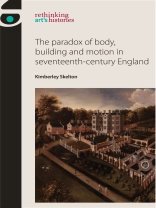This book examines how seventeenth-century English architectural theorists and designers rethought the domestic built environment in terms of mobility, as motion became a dominant mode of articulating the world across discourses encompassing philosophy, political theory, poetry, and geography. From mid-century, the house and estate that had evoked staccato rhythms became triggers for mental and physical motion – evoking travel beyond England’s shores, displaying vistas, and showcasing changeable wall surfaces. Simultaneously, philosophers and other authors argued for the first time that, paradoxically, the blur of motion immobilised an inherently restless viewer into social predictability and so stability. Alternately feared and praised early in the century for its unsettling unpredictability, motion became the most certain way of comprehending social interactions, language, time, and the buildings that filtered human experience. At the heart of this narrative is the malleable sensory viewer, tacitly assumed in early modern architectural theory and history yet whose inescapable responsiveness to surrounding stimuli guaranteed a dependable world from the seventeenth century.
表中的内容
1. The unease of motion2. Early seventeenth-century staccato boundaries
3. Mid-century mobility of language and architectural theory
4. Travel at home
5. The disciplinary distraction of motion
6. Motion as mode of perception
Bibliography
Index
关于作者
Dorothy C. Rowe is Senior Lecturer in History of Art at the University of Bristol
语言 英语 ● 格式 EPUB ● 网页 204 ● ISBN 9780719098260 ● 文件大小 9.6 MB ● 出版者 Manchester University Press ● 市 Manchester ● 国家 GB ● 发布时间 2015 ● 下载 24 个月 ● 货币 EUR ● ID 4784874 ● 复制保护 Adobe DRM
需要具备DRM功能的电子书阅读器








![的封面 [日] 隈研吾: 隈研吾谈建筑 的封面 [日] 隈研吾: 隈研吾谈建筑](https://static.world-of-digitals.com/thumb_webp/641/9781087988641.webp)



